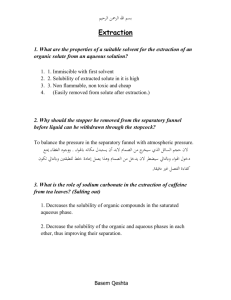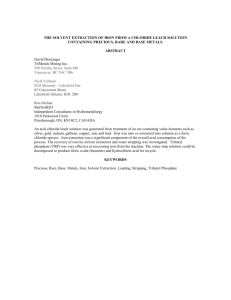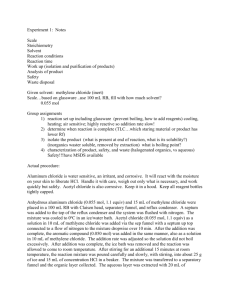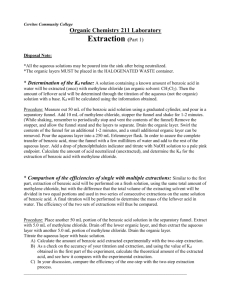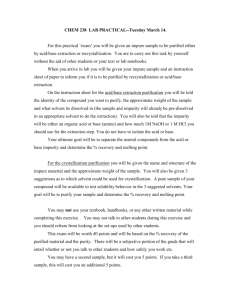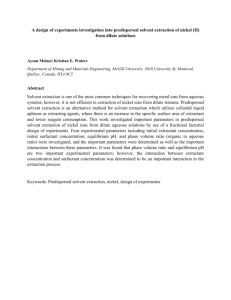Extraction
advertisement
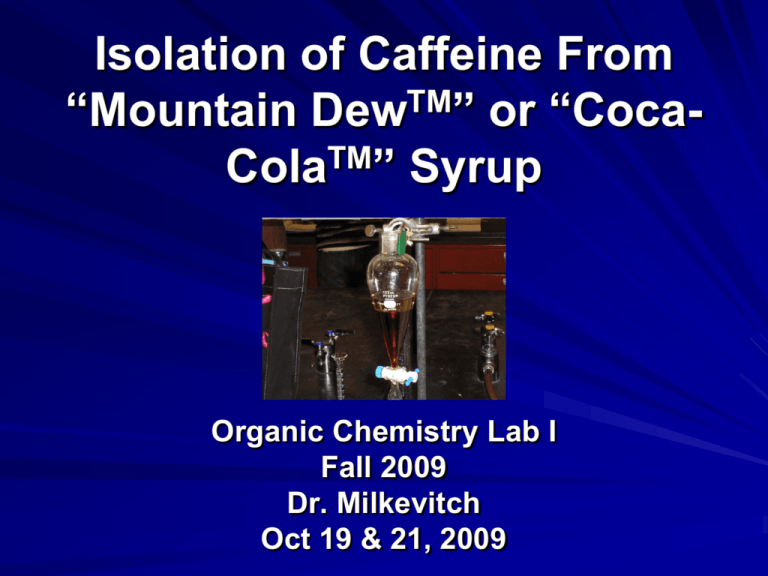
Isolation of Caffeine From “Mountain DewTM” or “CocaColaTM” Syrup Organic Chemistry Lab I Fall 2009 Dr. Milkevitch Oct 19 & 21, 2009 Extraction Today: Learn a separation method Extraction: “one of the most common methods of separating an organic product from a reaction mixture, or a natural product from a plant.” We will be examining liquid-liquid extraction, attempting to separate caffeine from softdrink syrup. How Liquid-Liquid Extraction Works You have some compound in a solvent (solute) Perhaps a reaction product You add another solvent to this solvent (which contains the solute) Solvents must be immiscible Immiscible: incapable of mixing Commonly water and a moderately polar/nonpolar solvent An equilibrium concentrations of solute is formed between the immiscible solvents Extraction, (con’t) Concentration of solute in each solvent Depends on the relative solubility of the solute in each solvent The solute will be more concentrated in the solvent in which it is more soluble Result: You can “move” a compound from one solvent to another Followed by purification, characterization, etc. What Extraction Is Used For To separate an organic product from water insoluble impurities Remember: water + moderately polar/nonpolar solvents are the most common in extraction Organic product preferentially drawn into the organic solvent in which it is more soluble Other components drawn into or remain in water Organic component “freed” from water soluble impurities Difference Between Extraction and Washing Extraction: removing a compound of interest from a solution or solid mixture Washing: removing impurities from the substance of interest Doing a Miniscale Extraction Pfft!!! Stopcock must be closed! Solvent + compound VENT!!! Keep finger on the stopper! After Initial Venting: Comes the Pfft! Shaking!! ! Followed by venting!!! Invert multiple times Do a minimum of 3 times!!!!!!! After Shaking, Separation! 1) Place separatory funnel back in Iron ring 2) Let layers separate 3) Drain off lower layer (methylene chloride) Important Tips Concerning Extraction Always keep your finger on the glass stopper when inverting the separatory funnel! Make sure the stopcock is closed! Never discard any layer until the experiment is done! Make certain the phases are thoroughly mixed by vigorously shaking the separatory funnel Vent frequently! This will prevent pressure buildup. If there is only one layer is separatory funnel and there should be two: Perhaps a wrong layer was used. Try adding a little water, and see if 2 layers form If there is still one layer, add a little organic solvent Since you didn’t discard anything, you are ok. More tips If you get an emulsion: Emulsion: a yucky suspension Stir the solution with a glass rod IF all else fails, add some salt water OR: filter through filter paper (slow and messy) OR: In this case, filter through some magnesium sulfate (will dry at the same time) Drying/Breaking Emulsion Separatory funnel ~ 1 cm layer of magnesium sulfate Small piece of cotton Erlenmeyer flask Procedure Measure out 40 ml of Coca-Cola or Mountain Dew syrup (your choice), transfer to 250 ml flask Dilute syrup with 40 ml ddH2O – Add 10 ml ammonium hydroxide – 40 ml of methylene chloride Pour solution into a 250 ml separatory funnel – MUST be supported by a ring stand + iron ring Stopper funnel, and invert Extract by invert/revert separatory funnel 3X followed by venting Do 3 cycles of this Place back on ring stand, Let layers separate It may take several minutes for layers to separate – You will probably see some emulsion Drain off lower methylene chloride layer into a clean erlenmeyer flask If you have an emulsion: – Break emulsion/ dry methylene chloride by passing the methylene chloride through magnesium sulfate lying on a cotton ball in a powder funnel (see figure) – Rinse magnesium sulfate with ~ 2 ml of methylene chloride, let this drain into the erlenmeyer flask Repeat the extraction – Add 40 ml of methylene chloride to the water layer (its remaining in the separatory funnel) Procedure (con’t) Follow same extraction procedure Drain off the methylene chloride – Again, if you get an emulsion, drain it through a fresh portion of magnesium sulfate Pour your organic (i.e., methylene chloride) layers in a preweighed erlenmeyer flask (+ boiling chip) – Evaporate off methylene chloride in the hood – Let cool Weight again, calculate weight of caffeine obtained Do a TLC of your caffeine – Check it against a caffeine standard Results/Conclusions Report the amount of caffeine that you obtained Conclusions: things to think about – Was your extraction successful? Did you obtain any caffeine? – What did it look like? (solid/liquid, color, etc) Any unique observations? Any problems/challenges? – If so, how did you deal with them? – If it wasn’t successful, then why? What did you think went wrong? How might you correct it in the future? Questions to Answer 1) What are 4 characteristics of a good extraction solvent? 2) What is a potential problem of adding too much drying agent to a solution? 3) When performing an extraction, why must the extraction solvent be immiscible with the solution that contains your reaction product? 4) We use extraction almost every day in the preparation of foods & beverages. Give 3 examples of such extractions. 5) Search for a method now commonly used to extract caffeine from coffee to manufacture decaffeinated coffee. Write a brief description of this method. You may search the internet or the library. Be sure to correctly reference your source(s).

